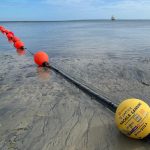A New Twist on Light to Boost Secure Quantum Fibre Optic Links

A team of South African and Chinese scientists have figure out how to harness multiple quantum patterns of twisted light (from a laser) so that it can be sent across a conventional single mode fibre optic cable (these can usually only support one pattern), which wouldn’t ordinarily be possible without a custom made fibre.
Quantum links are an attractive prospect for future networks because they’re often said to be virtually “un-hackable” as they rely on the use of single particles of light (photons), to transmit data encryption “keys” (QKD – Quantum Key Distribution) across an optical fibre. Should this communication be intercepted, the sender will be able to tell that the link has been tampered with and the stolen photons cannot then be used as part of the key, rendering the data stream incomprehensible to a hacker.
Admittedly this doesn’t stop hackers breaching the connection indirectly, such as by infiltrating the systems on either side of the link itself, but it would still help to make for a much more secure communication because any data that passes over the link itself should remain safe from prying eyes. Some operators, such as BT, have already built a network that can send data using such methods at speeds of 500Gbps over a distance of 120km (here).
Advertisement
Sadly to do this in global quantum networks tends to require custom multimode fibre cables in order to achieve the best speeds / distance (not so good for many existing Single Mode Fibre networks) and is limited by decoherence-induced mode coupling.
However the teams from the University of the Witwatersrand (South Africa) and Huazhang University of Science and Technology (China) sought to circumvent this restriction for single mode fibre. The way they did this was by “entangling the spin-orbit degrees of freedom of a biphoton pair, passing the polarization (spin) photon down the SMF while accessing multiple orbital angular momentum (orbital) subspaces with the other” (i.e. multidimensional entanglement transport).
The Test Setup (250 metres of SMF fibre)

Advertisement
The idea of sending more data down a fibre optic cable by twisting light into a vortex – Optical Angular Momentum (OAM) – is nothing new (here), although sending multiple quantum patterns of twisted light in this way and then pushing them over a conventional fibre optic link is very much a new approach.
The method also offers an alternative to spatial mode entanglement transport, which can facilitate deployment in legacy networks across conventional fibre.
Professor Andrew Forbes (Wits University) said:
“The trick was to twist the one photon in polarization and twist the other in pattern, forming “spirally light” that is entangled in two degrees of freedom. Since the polarization entangled photon has only one pattern it could be sent down the long-distance single-mode fiber (SMF), while the twisted light photon could be measured without the fiber, accessing multi-dimensional twisted patterns in the free-space. These twists carry orbital angular momentum (OAM), a promising candidate for encoding information.”
The related paper can be read online, although you’ll need a reasonable understanding of the science in order to make sense of it. Turning such research into a commercial solution is of course another matter.
Mark is a professional technology writer, IT consultant and computer engineer from Dorset (England), he also founded ISPreview in 1999 and enjoys analysing the latest telecoms and broadband developments. Find me on X (Twitter), Mastodon, Facebook, BlueSky, Threads.net and Linkedin.
« People’s Fibre Set to Rollout FTTP Broadband in North Wales





















































How would PMD delays affect this. We already have this to test without spinning photons to test. *mindblown*
> Multimode cable has a large-diameter core, which allows multiple modes of light to pass through it (more data = faster speeds)
That’s a very misleading statement.
Multimode fibre works at much *slower* speeds, because all those different modes interfere with each other. You can achieve 2km on multimode at 100Mbps, about 500 metres at 1Gbps, and a few tens of metres at 10Gbps.
Single mode is the preferred solution for telecoms networks: you can run much longer spans (20km typical, 80km+ with high powered lasers), and a single fibre can carry many lambdas each running at 10Gbps or more.
If anything deserves the label “legacy”, it’s multimode. Perhaps 10 or 15 years ago ,multimode was installed because the optics were much cheaper than single mode; but that advantage has evaporated now. I wouldn’t want readers to get the impression that multimode is the better choice for any new installation, because it absolutely is not.
Was about to say just this! (But you put it better)
The statements basically need to be completely reversed
My colleagues enjoyed hearing that MMF is faster. While they’re looking at their multi Tb DWDM links over SM fibre!
You’re of course correct, at that moment I was thinking more in terms of secure quantum communications rather than generally. Corrected.
> Corrected
Except the article still says “legacy Single Mode Fibre networks”. I just want to re-iterate that Single Mode Fibre is not “legacy” – it’s the modern cabling system, used in all new installations, with capacity limited only by the terminating equipment at each end.
If it has difficulty carrying entangled photons then that’s a pretty minor downside.
The BT lab installation referred to (120km / 500Gbps) must be using single mode fibre for the raw data stream, with the quantum key exchange overlaid.
Roadhouse
Campbells meatballs
Bad payers just down road
Tony Johns chicken dance